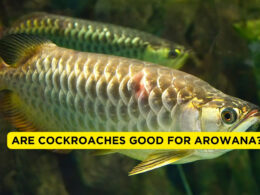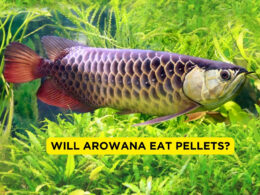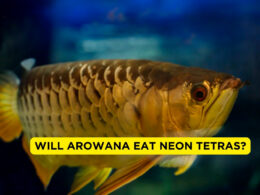In this article Show
Asian Arowana is fish that can grow in different natural habitats and are sizable. The fish are sizeable, and their mouth is usually positioned in an upright way. The fish has many features, such as they are short they have both soft dorsal and anal fins.
Also, they contain a very long tail fin which helps them swim swiftly in their natural habitat. They exist in many different forms with special breathing features.
For instance, the Asian Arowana fish take in the air found at the water’s surface, unlike other fish such as Nile perch. Despite the fish existing in many forms, they also come in different colors, such as blue and shining red.
The article below summarizes the Asian Arowana fish, their habitat, care, tank size, and breeding.
Also worth reading;
- Are Arowana Fish Aggressive? All You Need to Know
- Why Does Arowana Jump Out Of The Tank? (Possible Reasons)
- What Do Arowana Fish Eat? (Best Food In The Aquarium For Arowana)
Asian Arowana- Habitat, Care, Tank Size, Breeding
The following are the habitat, care, tank size, and breeding of Asian Arowana;
1. Asian Arowana Habitat
Asiana Arowana is treasured a lot by many sellers because of its unique features, and they are rare to find.
Many countries, such as the United States, have banned such fish and are against selling and buying in markets, except for other people illegally in the black market.
The banning of Asian Arowana fish trading was due to increased murder activities in the country. The Asian Arowana usually lives in natural habitats, especially in black-water rivers. The black water rivers are commonly located in southeast Asia, hence the name Asiana Arowana species.
The fish prefer living in swampy areas where water flows steadily, unlike in natural rivers with high pressure. Also, the fish are found in lands that are a bit wet.
When it comes to fish, Asian Arowana depends on other fish for food. They chase smaller fish in the water or wetlands and hunt them as their prey. Also, Asiana Arowana feeds on other swampy insects such as mosquitos found in the swamp.
The fish can quickly die if there are no other swampy insects or other small fish for food.
Despite their unique feeding feature, they also have a special breathing feature where Asian Arowana fish can survive in environments with freshwaters without any difficulties as they quickly adapt to environmental changes.
Due to their unique breathing feature, the Asian Arowana fish can live in environments with limited oxygen, unlike other fish such as the Nile perch. Their distinctive features of surviving in different environments increase the demand by sellers and buyers in black markets even though some countries are against Asian Arowana trade.
The feature of the Asian Arowana fish surviving in a limited oxygen area increases their chances of preying on insects present in the area. For instance, many insects or other fish species find it difficult to survive in environments with low oxygen, and those staying have weak immunity and thus weaker.
Their weakness increases the Asian Arowana hunting chances hence improving their health conditions, and that is why Asian Arowana surviving in low oxygen environments are usually thicker than other species.
Despite the Asian Arowana surviving in a freshwater environment, low oxygen areas, and swampy areas, they also stay in places with flooded forests, lakes with fresh waters and not salty waters, and ponds.
The Asian Arowana usually hides during the day and only comes out at night to hunt other smaller species of insects. They usually hide in other aquatic plants found in or on the water’s surface.
2. Asian Arowana Diet Care
Asian Arowana fish are fish species that feed on anything edible as long as the food substance can enter their mouth. Most of the species hunt other fish and insects near the water surface and prey on them instantly.
Despite the Asian Arowana feeding on small fish and insects, they also feed on large animals such as birds and snakes left near or on the water’s surface. Most of these species are carnivores as they prey on meat and not aquatic plants.
3. Asian Arowana Tank Size And Shape
The species exist in different forms; hence their tank size differs from one to another depending on their size. Most of the Asian Arowana require approximately 240 to 260-gallon tanks to fit in perfectly.
The tank is usually filled with some components, such as small stones at the bottom. If you choose to keep the Asian Arowana species by yourself, ensure you buy a tank with all conditions to enable the species to survive without any difficulties.
The necessary conditions for Asian Arowana species to survive include; the existence of aquatic plants in the gallon tank, ample space for the fish to swim, and freshwater to increase the oxygen level in the water tank.
Ensure the water inlet and outlet function effectively and ensure the water is always fresh to improve their surviving conditions. Also, ensure there is enough gravel at the bottom of the tank to hold the tank in position when the Asian Arowana is swimming, hunting their prey for food.
For smaller Asian Arowana, place them in a 50-gallon tank but move them once they grow and put them in larger tanks to keep them alive. Also, it is essential to place the species in a well-decorated tank to keep the species jovial and not stressed at all.
You may use rockwork to decorate the gallon tank or any other decorating agent recommended. Finally, consider the weight of the species. For instance, if the species is more than 5 kg, consider using a tank of 240 to 265.
You should need to know: Why Does Arowana Jump Out of the Tank?
How To Take Care Of The Asian Arowana Species
1. Type Of Asian Arowana
Before considering the idea of keeping Asiana Arowana, first, inspect the type of Asian Arowana that matches your preference. For instance, choose a silver Arowana since they are readily available and are not banned.
Silver Asian is also cheaper than other species, and they are attractive because their bodies are covered with silvery scales that are attractive, and their body is long and sleek.
2. Temperature And Type of Water
Also, consider the water conditions for your Asian Arowana species. The type of species survives in water temperatures of approximately 73 to around 85 degrees F. Also, ensure the pH of the water ranges from 6.4 to 7.7.
Moreover, avoid using hard water to keep the species. Insufficient quality water reduces their chances of surviving and reduces their lifespan, thus dying quickly. It is advisable to change the water in the gallon tanks frequently to increase their survival at least once a week.
Also, you may consider installing a water filtration system in the tank to remove dirty and poor water and allow the flow of freshwater into the tank. Water changes must be moderate and frequent, allowing the fish to stay longer without any stress.
3. The Diet Of The Species
All Asian Arowana species are carnivores as they hunt other smaller fish and insects for prey. For instance, the species prey on animals such as frogs, snails, and snakes on the water surface and other insects such as mosquitoes.
In some situations, where there are no smaller animals and insects, the species can be omnivores. When taking care of the species, ensure the feeding schedule is regular, and there is both meat and other diet recommended for their survival.
Such species prey on crustaceans and crabs. Allow them to feed on such a diet present in the tank. Avoid limiting the species’ diet as they can quickly die despite being placed in appropriate water temperatures and freshwaters.
Other Species Living Mates
Asian Arowana species require tank mates to reduce stress and increase their chances of survival. Most Asian Arowana species, if left alone, become angry with time and become more stressed.
Therefore, ensure you keep at least four Arowanas of the same age in the same tank to keep each other company. Also, separate smaller Arowanas from bigger ones to protect them from the angry features of the adult Arowanas.
Further, ensure safety for all Arowanas in the gallon tank, especially for the growing Arowanas. Also, when placing the same-age Arowanas together, ensure they relate with each other well and if not, consider separating them and placing them in different tanks. While choosing Arowana tank mates, consider the following factors;
- Consider the angriness of the species before placing them together.
- Choose a bigger tank for the Arowana mates to give them a hard time fighting.
- Introduce the Asian Arowana species to the aquarium plants first before introducing them to meat.
Finally, avoid positioning high-valued Asian Arowana with other species as it is too risky and can affect the other species.
Asian Arowana Breeding Features
Asian Arowana breeding features differ from other common fish species. The sex of the species lasts longer than other species, approximately more than five years.
When it comes to breeding, a young Asian Arowana takes about 3 to 4.5 years before breeding, and the breeding process takes place only in natural habitats.
A female Asian Arowana lay egging differs from other common female fish. For instance, the species lay approximately 13 to 110 eggs during the breeding process. Fertilization of the eggs is usually external, where a male Asian Arowana breeds the eggs in the mouth until fertilization occurs.
Other Asian Arowana males may prefer carrying the young Arowanas in their mouth until they become more significant to protect them from other aggressive Arowanas. The breeding process usually takes place in January and December, when it is the flooding season.
Conclusion
Asian Arowana species are pretty expensive since they are difficult to maintain and are in high demand. The species cost approximately $320,000 because they are rare, and people believe they bring wealth for the sellers and traders.
Therefore, it is essential to care for the Arowanas well to increase their surviving features. The article above shows factors to consider when choosing Asian Arowana to grow, maintaining the species and breeding features.
Finally, when positioning the Arowanas, ensure you consider the sex gender and avoid placing same-sex together. Instead, mix them effectively to allow the breeding process to take place successfully.
In this video, we dive deep into all you need to know about keeping Asian Arowana!










